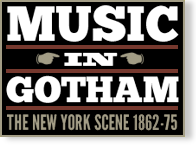Thomas Symphony Concert: 5th
Event Information
Venue(s):
Steinway Hall
Conductor(s):
Theodore Thomas [see also Thomas Orchestra]
Price: $1.50; $1; $.50 extra reserved
Event Type:
Orchestral
Record Information
Status:
Published
Last Updated:
2 May 2025
Performance Date(s) and Time(s)
21 Mar 1874, 8:00 PMPerformers and/or Works Performed
Citations
“The voice of the singing bird is heard in the land. The air is resonant with the sound of concert singing. On Saturday night, for instance, Theodore Thomas gave his fifth Symphony Soiree. To be sure there was not much singing in it, but what there was was good in its way, being furnished by a band of trained German vocalists, with Graf, the tenor, as the soloist. The vocal passages occurred in Liszt’s ‘Faust’ symphony, which was the feature of the programme. It had been given in this city some years ago by the Philharmonic Society, but to most of those who heard it on Saturday night it came as a novelty. In it the composer has sought to depict musically the characters of Faust, Gretchen and Mephistopheles, and when his intent is once known the work assumes great significance. Apart, too, from its poetic meaning, it is wonderful if viewed only as a study of orchestral treatment. Beethoven’s fifth symphony and Weber’s ‘Euryanthe’ overture were also included in Saturday’s programme.”
“A most remarkable musical work was presented for the consideration of a very numerous audience on Saturday evening at Steinway Hall. One of the grandest of all the works of German literature is the ‘Faust’ of Goethe, and it is suggestive of sublime ideas to any composer. Liszt has made it the medium of introducing to the world a symphony in three character pictures (characterbildern), divided as follows:--‘Faust,’ allegro; ‘Gretchen,’ andante; ‘Mephistopheles,’ scherzo and finale, for grand orchestra, tenor solo (Mr. J. Graf), and male chorus (Turner Liedertafel). Mr. Thomas has nobly fulfilled the purpose to which years ago he devoted himself, organizing an orchestra capable of producing any work and giving to the public from an exhaustive répertoire everything that can be found in the realms of classical music. Through him the American public have learned to know and revere the glorious names that adorn the pages of musical history. In the production of a work like the ‘Faust Symphony’ of Liszt Mr. Thomas does good service to the music. He strips off the disguises which the disciples of the ‘music of the future’ throw around it by learned disquisitions and elaborate theories, and exposes it in all its grotesqueness and deformity. Such a work as the one under consideration may be taken as a fair specimen of the extravagances to which this school will drive composers. A wilder, more incoherent and more thoroughly audacious composition has never been submitted to any audience. It seems more like the phantasmagoria of a disordered mind than anything else. Yet there are some interesting features in it, the principal one being the wonderful instrumental effects to be found in every number. There is one little theme particularly that runs through the work and is presented at the most unexpected places, always in a different form. But the general tenor of the music is unhealthy. Strange effects, fragmentary phrases and chaotic thoughts do not constitute music. The performance was absolutely perfect, and considering the enormous technical difficulties of the composition, no higher compliment could be paid to this orchestra. Still it seemed akin to desecration of the talents of the noble band to give them a work which is fitter for Charenton than Steinway Hall. The glorious fifth symphony in C minor of Beethoven was like ‘the balm of Gilead’ after Liszt, as was also the ever fresh overture, ‘Euryanthe,’ that preceded ‘Eine Faust Symphony.’ Both works were played to a charm. Mr. Thomas was called out repeatedly by the unanimous voice of the audience, and bowed his acknowledgments amid the wildest enthusiasm.”

